Charlie Russell loved to fly, and he seldom phoned first those times when he would fly his Kolb ultralight airplane north from Hawk’s Nest ranch on the boundary of Waterton Lakes National Park, Alberta, to our “ranchette” near the Crowsnest Pass. We would hear the thrum of the plane’s Rotax motor bouncing off the nearby Livingstone Range, then the tiny white two-seater, looking like a giant lawn dart, grew suddenly loud as he buzzed the place, wagging his wings close enough for us to see his snaggle-toothed grin. Our horses would tear down the field, eyes rolling from his low approach. He would circle over the road, then sail in under the Fortis power line, set the plane down on the gravel and taxi up to our cattle guard. Then he’d get out, grab a length of rope from the cockpit and tie off the plane to a fence post with a cowboy slip knot so the wind couldn’t blow it over. He had long promised to take my wife Myrna for a ride, and one day she called him on it. “Well, I guess today’s the day then,” he grinned. I didn’t like the look of the clouds over Centre Peak, but Myrna’s face said, “You don’t get a vote.”
“Just tell me that you don’t have a halibut jig tied to the tail wheel this time.”
“What’s he talking about?” Myrna demanded.
“Ha!” laughed Charlie. “He’ll tell you later.”
Charlie Russell died on May 7 in Calgary due to complications following a five-hour surgical procedure. Charlie used up his nine lives long ago, but his death at 76 was still shocking to those who knew him well. Few people have lived as intensely as this man, or as dangerously. He has flown in some of the worst conditions on earth and walked, or crawled (with a broken back one time) away from both a hang-glider and an ultra-light crash, and over time he prevailed in a number of forced landings. He is, he was, internationally famous for the ground-breaking work he and the artist Maureen Enns did at Kambalnoye Lake, Kamchatka, in Russia, living in close proximity with brown bears and raising orphaned cubs which not only survived the wilds but eventually reproduced. A mentor to many naturalists, his experiments in “exploring the possibilities of trust” challenged the prevalent orthodoxy of his day, which held that bears which have no fear of humans are always extremely dangerous, and that all bears are unpredictable and therefore always a threat to humans. Yet he was wise enough to know that what he learned working with those wild bears in B.C. and Kamchatka, in true wilderness settings, should not be applied by the layman to human-influenced bears in our southern national parks.
Being famous didn’t make Charlie rich, by any means. In fact there is a Charlie Russell GoFundMe initiative on right now to lift his estate out of debt.
Charlie was raised in bear country and learned all the skills of mountain bush craft and horsemanship guiding hunters on his father’s pack-train. In 1960, Charlie and his brother Dick roughed it through Canada and Alaska to help Andy Russell make his groundbreaking film, Grizzly Country. After studying photography in New York and a stint living in New Zealand with his first wife, Margaret, Charlie took up ranching at Hawk’s Nest, his family home, but his heart wasn’t in it and he spent a lot of his time working on conservation projects, such as the Waterton Biosphere Reserve initiative. Many bears were dying at the hands of ranchers and hunters in southwest Alberta at that time. This bear of a man, Russell, was angered by the carnage, for as he often growled, “Anything that hurts the bears, hurts me.” He became the first Canadian rancher to deliberately move cattle carcasses to safe places on his ranch near the park boundary, so that bears could feed on them without being shot.
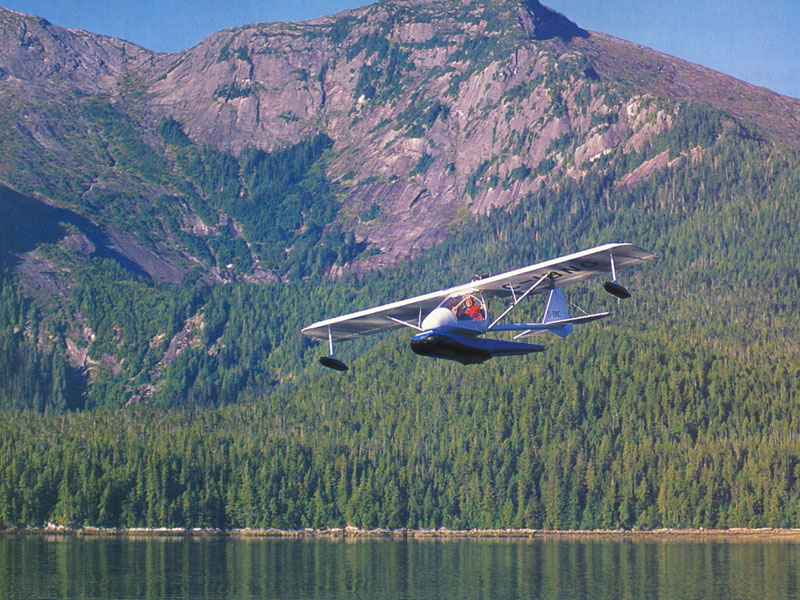
Eventually, Charlie gave up on ranching and in the 1990s, he took a job guiding tourists on grizzly bear watching tours in the Khutzeymateen inlet of B.C. Charlie’s superb talent at reading ursine body language, and his sensitive, ego-free approach to all wildlife allowed for close encounters of the ursine kind. Myrna and I are two of the many people that have sat with him on a big driftwood log at the water’s edge as a female grizzly grazed on sedges at our feet, unafraid of us, and offering no threat to us. As a former park warden, I helped to capture many bears, but I never felt as reassured around them as I felt in Charlie’s company. His skill as a bear guide led to an offer in 1991 to work with filmmakers Jeff and Sue Turner of Princeton, B.C. With Charlie’s help, they shot a famous BBC documentary on the Kermode “Spirit Bears” of Princess Royal Island. Charlie worked on documentaries, wrote books, collaborated with conservation groups and biologists and helped shape public opinion to push for a grizzly sanctuary in both the Khutzeymateen and Kamchatka, and a protected area for Kermode bears on Princess Royal Island.
In 1993, the Turners’ plan called for Charlie to provide and pilot an ultralight plane, capable of water landings, to be used as an aerial camera platform. Charlie and his late son Anthony Russell began building the plane at Hawk’s Nest — all over Hawk’s Nest, since he didn’t have a big enough barn for the project. Every building on the place had a piece of the plane in it and Charlie was getting increasingly frantic to get the thing riveted together as a deadline for departure for the island loomed. On a snowy March day, I joined filmmaker Jeff Turner to help Charlie with some last-minute detailing. We worked all day; darkness found us riveting the cockpit canopy carefully on to thin steel tubing. I suddenly stubbed my toe on a snow-covered object. “Shit! What’s this thing Charlie?” Charlie peered down at it for a second, distracted, bent down and swept the snow off it with his boot. “It’s just the in-flight computer.”
“Oh, is that all it is? Wow. I thought I had stepped on something important.”
I worried about that computer later that spring, when Canadian Geographic commissioned me to write a feature article on the Kermode bears with Charlie to supply the photos. As a result I spent about four weeks that summer and fall on the island, hosted by the Turners at their camp. One did not just swan around taking notes when around the hard-working Turners, and I soon found myself humping camera gear through the rainforest with Charlie. The white bears were living up to their reputation as ghosts of the rainforest, staying out of sight and waiting for the coho to run. Charlie had already befriended both black and white bears he encountered in the bush, and could identify individuals by size, shape, and colouration. One day, we were sitting on a log taking a break while a black bear fished in a desultory manner nearby. The rains, and the main run of salmon that rain would trigger, had not yet begun. Charlie grinned at me, ran his fingers through his thick black hair, then leaned over in a bear-like manner and stirred the water with a calloused paw, peering intently into the stream. The black bear splashed over and took up a position next to him almost touching his shoulder. I froze, too startled to get my little Balda camera out of my pack. The bear peered intently into the water, and then, realizing there was no fish in sight, backed away slowly giving Charlie a sidelong glance. His body language said, “Dude — that is not funny.”
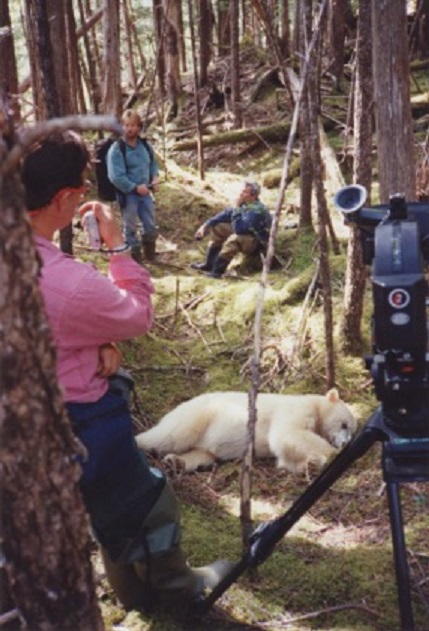
We were working one day in a creek bed, picking our way among slimy boulders and fish guts, stringing up a thousand feet of climbing rope between fir trees for an overhead camera sequence. Charlie pointed out a giant flat topped boulder in midstream. “I was playing with a bear on that rock one day, and things got out of hand.”
“Playing?”
“Yeah. I was up there taking a break, and he came down the bank, spotted me, and came up to visit.”
“To visit?”
“Yeah. I’ve come to know him pretty well. I could tell he was feeling playful. He was really inviting me to wrestle. I wasn’t sure if I should, but he was so friendly. Anyway, he stood up. He had a really mischievous gleam in his eye, and I thought what the heck. So I got ready to grapple with him. God, they are so strong! He just knocked me right over. I landed on those boulders.”
“Jesus Christ!”
“Yeah. I could tell he was surprised. I looked up, and he was peering down at me. I think it really puzzled him, how weak humans are. He didn’t mean to hurt me. I was really banged up for a while there.”
“Jesus H. Christ on a crutch. You were playing King-of-the-Castle with a bear?”
“Yeah. I think I went a bit too far, that time,” he added, sheepishly.
Those who know Charlie’s books might say he should have known better. He had wrestled with a bear before, in Waterton Park in the ‘80s when he and his son, the late Anthony Russell, then age 11, wandered in between a black bear sow and her cubs. The little sow attacked, and Charlie and Anthony were soon in a tag team bout with her. She knocked Anthony down and Charlie went after her with fists and boots. When she got on top of Charlie, Anthony, armed with a piece of elk antler he had found earlier, whacked her over the head. She then bit Anthony on the behind, and Charlie again attacked until the sow finally retreated. The sow was fine, and the humans escaped with bruises and puncture wounds, but Charlie always said that Anthony had saved his life that day.
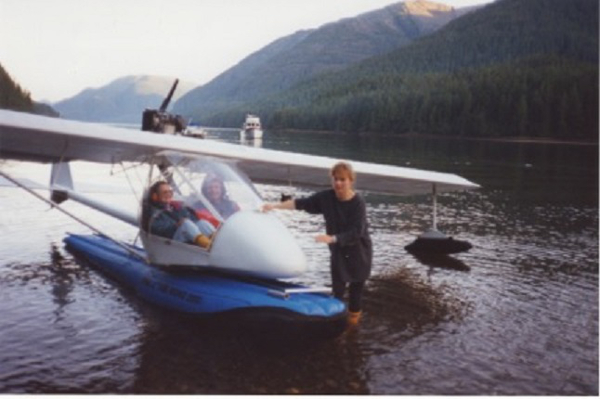
But about that halibut jig. We were sitting in the cook tent over coffee one morning with Sue and Jeff and their daughter Chelsea, when Charlie popped the question I had been dreading. “Will you fly with me?”
Charlie knew I hated flying. I nearly choked on the coffee, set the cup down. “I’d be happy to,” I lied.
The two us, both heavyweights, climbed into the little plane and strapped in, while Jeff Turner pushed us away from the pier. We had a windscreen in front of us, but were otherwise open to the weather. The motor sits behind the passengers on this craft. There was no intercom, so once the motor started conversation was by sign language. We taxied down the inlet and I could see why it was going to be hard to keep this plane aloft just by force of my willpower alone, since there were no armrests to grip in white-knuckled fear while will-powering. Charlie punched me in the shoulder, a big grin on his face, and opened the throttle as we raced down the inlet. This is a short takeoff plane, but our run seemed to go on forever, and we did not lift off the water. Frowning, he slowed down and we taxied back to try it again. I can’t recall how many times we attempted take-off, it seemed like 10 but was probably only three. At last we returned to the pier, the motor idling. “Well, I guess it’s just not in the cards today,” I said, happily.
“No problem,” said Charlie. “I know what we need. Just stay in the plane while I get it.”
He hurried up the beach to camp, and soon returned with his fishing tackle box in one paw. As I watched, puzzled, he pulled out a lead halibut jig with its attached hook, and tied it to the tail-wheel with some fishing line. “We’ve got it now,” he said with a happy grin as he settled back behind the controls.
“We’ve got it? Are we trolling for halibut now?” I asked, mystified.
“Ha! We’re going to catch some air.”
Once more we hurtled down the inlet, two porkers making the ultralight nose heavy. But this time, the halibut jig was just enough tail weight (at 17.6 ounces) to pull the tail down allowing the wings to catch some lift. And we flew around and around up above Princess Royal Island and Laredo Inlet looking for white Kermodes and scared the hell out of some tourists in a yacht in an 80-mph swoop. And except one time when I took a ride in a sailplane, I felt about as close to being an eagle, and like an eagle, oblivious to fear, as I have ever been.
In Kamchatka, Charlie learned how to find a hole in the fog and spiral his plane up into the clear sky. He made many personal sacrifices in choosing to devote his life to finding a way through the foggy notions people have about bears, and our relationship to nature. The best way to honour Charlie is to make some new holes in the fog of misunderstanding that keeps people from living at peace with nature, and therefore, with ourselves.
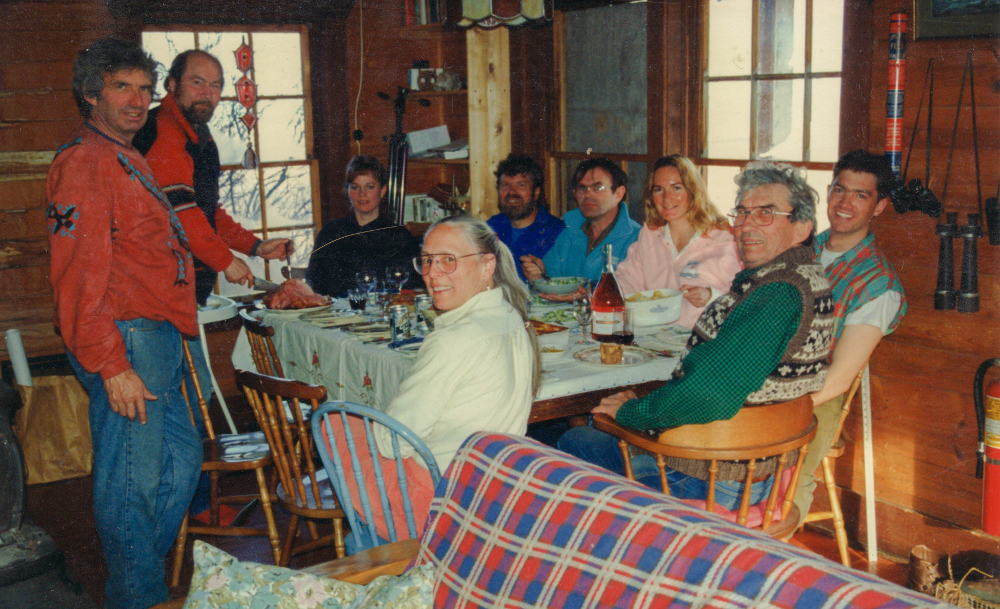
Read more: Environment


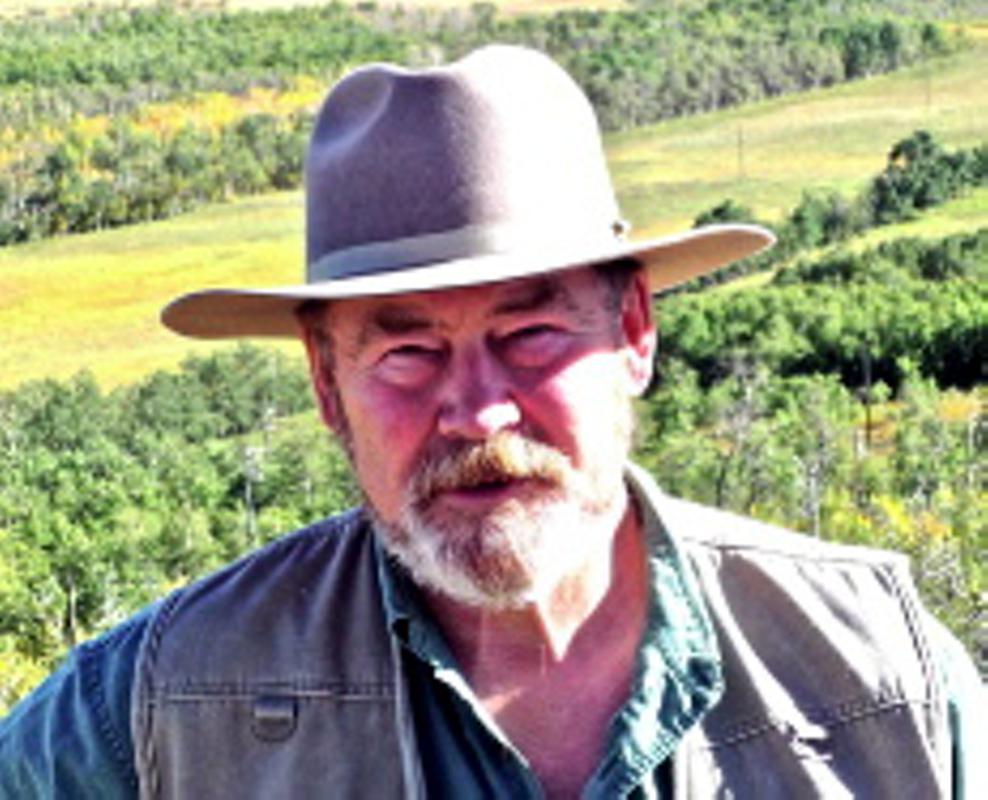
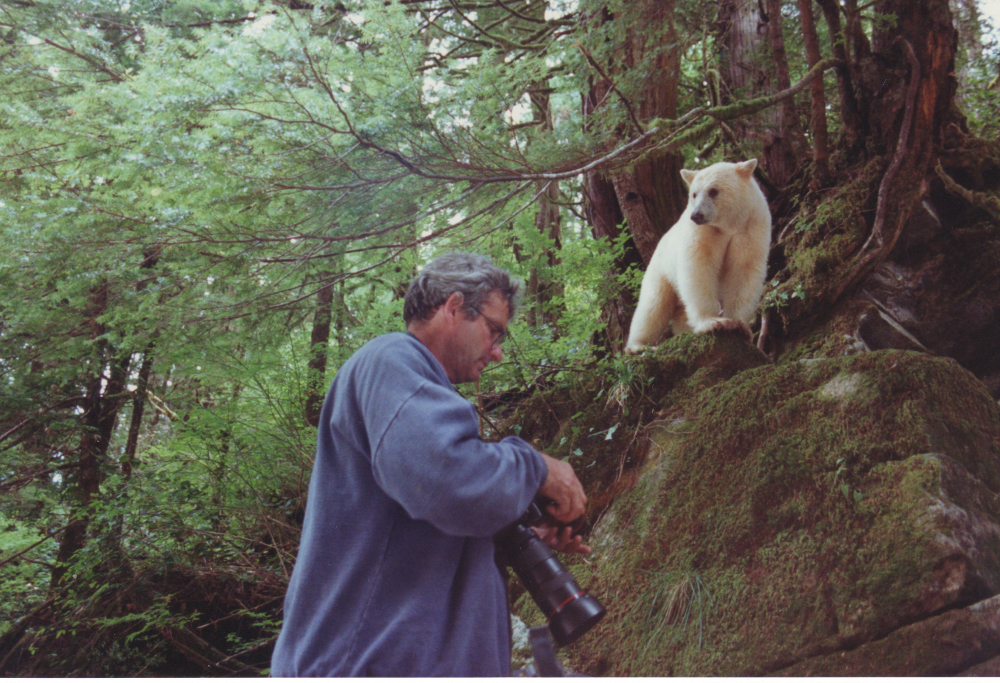












Tyee Commenting Guidelines
Comments that violate guidelines risk being deleted, and violations may result in a temporary or permanent user ban. Maintain the spirit of good conversation to stay in the discussion and be patient with moderators. Comments are reviewed regularly but not in real time.
Do:
Do not: